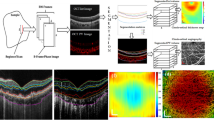Abstract
Segmentation of retinal layers with central serious chorioretinopathy (CSC) in Spectral Domain Optical Coherence Tomography (SD-OCT) images is significant for quantitative analysis including the volume, location and shape of CSC region. In this paper, we present an automatic segmentation method to segment retinal layers based on graph theory and the previous B-scan information. Firstly, the boundaries of Vitreous-ILM (inner limiting membrane), ONL (outer nuclear layer)-IS (photoreceptor inner segments) or LR (lesion region)-RPE (retinal pigment epithelium), and RPE-Choroid are estimated based on graph search model. Next, a flexible search region is constructed by calculating the thickness between Vitreous-ILM and ONL-IS based on the difference between two consecutive B-scans, which is used to refine the ONL-IS. The proposed method was quantitatively evaluated in total of 200 B-scan images from 5 abnormal cubes with CSC and 5 normal cubes, where we choose 20 B-scan images randomly in each cube. Experimental results illustrated that the proposed method can segment retinal layers in SD OCT images with CSC accurately. And the overall mean absolute boundary positioning differences and the overall mean absolute thickness differences compared to manual segmentation results are 3.68 ± 2.96 μm and 5.84 ± 4.78 μm.







Similar content being viewed by others
References
Chiu SJ, Li XT, Nicholas P, Toth CA, Izatt JA, Farsiu S (2010) Automatic segmentation of seven retinal layers in SDOCT images congruent with expert manual segmentation. Opt Express 18:19413–19428
Dijkstra EW (1959) A note on two problems in connexion with graphs. Numer Math 1:269–271
Dufour PA, Ceklic L, Abdillahi H, Schroder S, De Dzanet S, Wolf-Schnurrbusch U et al (2013) Graph-based multi-surface segmentation of OCT data using trained hard and soft constraints. IEEE Trans Med Imaging 32:531–543
Fabritius T, Makita S et al (2009) Automated segmentation of the macula by optical coherence tomography. Opt Express 17:15659–15669
Gurusamy R, Subramaniam V (2017) A machine learning approach for MRI brain tumor classification. Computers Materials & Continua 53(2):91–108
Huang D, Swanson EA, Lin CP, Schuman JS, Stinson WG, Chang W et al (1991) Optical coherence tomography. Science 254:1178
Kafieh R, Rabbani H, Abramoff MD, Sonka M (2013) Intra-retinal layer segmentation of 3D optical coherence tomography using coarse grained diffusion map. Med Image Anal 17:907–928
Lee K, Niemeijer M, Garvin MK, Kwon YH, Sonka M, Abramoff MD (2010) Segmentation of the optic disc in 3-D OCT scans of the optic nerve head. IEEE Trans Med Imaging 29:159–168
Li A, Shao G, Du P, Ding S, Su J (2015) Numerical studies on Stratifield rock failure based on digital image processing technique at mesoscale. Computers Materials & Continua 45(1):17–38
Niu S, Chen Q, de Sisternes L, Rubin DL, Zhang W, Liu Q (2014) Automated retinal layers segmentation in SD-OCT images using dual-gradient and spatial correlation smoothness constraint. Comput Biol Med 54:116–128
Song Q, Bai J, Garvin MK, Sonka M, Buatti JM, Wu X (2013) Optimal multiple surface segmentation with shape and context priors. IEEE Trans Med Imaging 32:376–386
Srinivasan VJ, Monson BK, Wojtkowski M et al (2008) Characterization of outer retinal morphology with high-speed, ultrahigh-resolution optical coherence tomography. Invest Ophthalmol Vis Sci 49:1571–1579
Tan O, Li G, Lu AT-H, Varma R, Huang D, A. I. f. G. S. Group (2008) Mapping of macular substructures with optical coherence tomography for glaucoma diagnosis. Ophthalmology 115:949–956
Tang Z, Ling M, Yao H et al (2018) Robust image hashing via random Gabor filtering and DWT. Computers Materials & Continua 55(2):331–334
Wang M, Munch IC, Hasler PW, Prünte C, Larsen M (2008) Central serous chorioretinopathy. Acta Ophthalmol 86:126–145
Yang Q, Reisman CA, Wang Z, Fukuma Y, Hangai M, Yoshimura N et al (2010) Automated layer segmentation of macular OCT images using dual-scale gradient information. Opt Express 18:21293–21307
Yazdanpanah A, Hamarneh G et al (2011) Segmentation of intra-retinal layers from optical coherence tomography images using an active contour approach. IEEE Trans Med Imaging 30:484–496
Acknowledgements
The authors sincerely thank the reviewers whose valuable comments have improved this paper. The work is supported by the National Natural Science Foundation of China under Grant No. 61701192, 61671242, 61671220, the Natural Science Foundation of Shandong Province, China, under Grant No. ZR2017QF004, China Postdoctoral Science Foundation under Grants No. 2017M612178, the Shandong Provincial Key R&D Program (2016ZDJS01A12), the National Key Research and Development Program of China (No. 2016YFC0106000), The Shandong Provincial Key Research and Development Project (2017CXGC0810), the Open Fund Project of Key Laboratory of Intelligent Perception and Systems for High-Dimensional Information of Ministry of Education (Nanjing University of Science and Technology) (No.JYB201707). The authors would like to thank Prof. Songtao Yuan for helping to collect data. K. Gao and W. Kong performed most of the experiments, data analysis and manuscript writing. Prof. Dengwang Li and Prof. Yuehui Chen gave critically reviewed the study proposal and technical editing. Prof. Sijie Niu provided scientific proposals, conception, analysis and technical editing.
Author information
Authors and Affiliations
Corresponding author
Additional information
Publisher’s note
Springer Nature remains neutral with regard to jurisdictional claims in published maps and institutional affiliations.
Rights and permissions
About this article
Cite this article
Gao, K., Kong, W., Niu, S. et al. Automatic retinal layer segmentation in SD-OCT images with CSC guided by spatial characteristics. Multimed Tools Appl 79, 4417–4428 (2020). https://doi.org/10.1007/s11042-019-7395-9
Received:
Revised:
Accepted:
Published:
Issue Date:
DOI: https://doi.org/10.1007/s11042-019-7395-9




